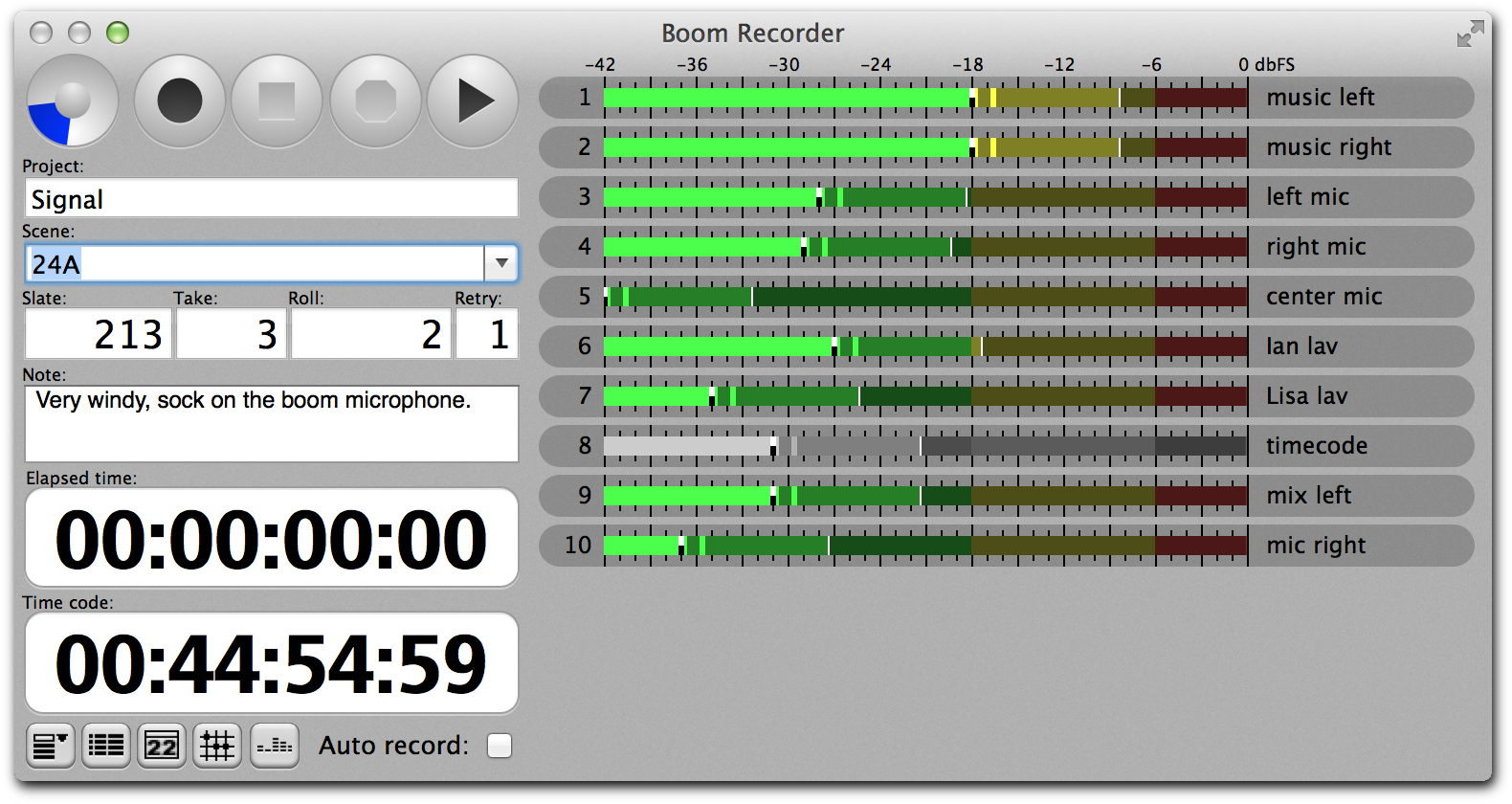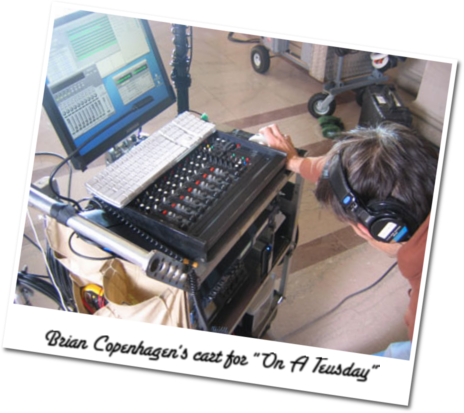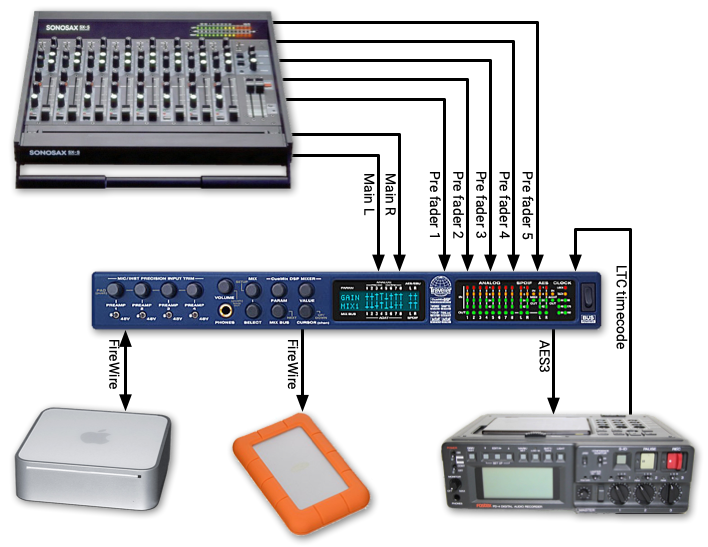Boom Recorder
Boom Recorder is a multitrack field recorder. It has been designed to be used during the high stress production of a tv/film shoot,
a concert or a live stage performance. Boom Recorder has many metadata fields that are used during a film production, making it easy
to keep track of the many audio files in post production. For concerts and live stage performances it is possible to record up to
256 (Boom Recorder Pro) tracks continuously for many hours.

The download version includes a 30 day trial license which is equivalent to Boom Recorder Pro. This will give you time to test
the full production flow and decide which of the two licenses: Boom Recorder Pro or Boom Recorder Lite you would like to order.
After you have bought a Boom Recorder license from Share-it you can enter the license code and in Boom Recorder's
License panel. If you buy Boom Recorder via the Mac App Store, the App Store will install Boom Recorder for you.
Boom Recorder Lite (2 channels)
Boom Recorder Pro (256 channels)
Features
Audio Recording
- WAV (Broadcast Wave Format) with iXML metadata and RF64 for files larger than 4 GByte.
- CAF (Core Audio Format)
- 16 bit, 24 bit integer and 32 bit floating point sample format.
- Mono, Stereo and Polyphonic files up to 256 tracks.
Metadata and sound reports
Metadata such as project, scene, take and timecode is recorded together with the audio.
Sound reports in HTML and CSV will be generated after each recording. Modifications to the
metadata may be modified after the recording as well.
Timecode
Boom Recorder is able to read a LTC timecode signal from an audio input. When this LTC signal enters the
same audio interface as the sound, the timecode will be sample accurate depending on the quality of the LTC signal.
For long recordings it is adviced to discipline the word clock of the audio interface with the same clock
that generates the LTC timecode signal. You can configure the actual sample rate of the word clock in Boom Recorder
to handle film-to-tv / tv-to-film, pullup / pulldown.
Miscellaneous
Includes fast acting peak-and-hold and VU level meters, both in horizontical and vertical directions, and
a spectrum analyzer.
A pre record buffer may be used to record a few second before you press the record button, in case you missed
a cue.
Realtime mixing and routing on inputs and outputs.
Long recording can be automatically split based on the length of an audio file.
Projects
Here are some of the projects that have been recorded with Boom Recorder:
- Charles Maynes: Flags of Our Fathers
- Peter Bently: Mad Men
- Mark Krupka: Project Runway Canada
- Patrick Ramsay: Deck The Halls, AVP2 (Alien vs Predator 2), Christmas Cottage, "Stargate Universe", Love Happens,
The Invisible, Black Christmas, Alien Trespass, "The Killing" (Season 1), "Alcatraz" (Season 1), Arrow (pilot), Altered Carbon
- Brian Copenhagen: On a Tuesday
- Richard Bryce Goodman, C.A.S: Starship Dave, Tropic Thunder, Limelight, He's Just Not That Into You,
Night at the Museum: Battle of the Smithsonian, All About Steve, The Switch, The Roommate, Hop, Everybody Loves Whales
- Rob Young, C.A.S: Elegy, Tale of Two Sisters
- Andy Deacon (Delta Broadcast): 2012 Olympics Cermonies Broadcast Multi track
- Steve Weiss has been using Boom Recorder since 2006 on various Movies and TV series, including:
"Saving Grace", "Franklin & Bash", "Body of Proof", "1313 Mockingbird Lane" (Pilot), Major Crimes
Quotes
Boom Recorder is the field recordists dream, It is the epitome of directly serving the needs of location recording with a simple
and direct robust program which appears to be quite sturdy in every way....
Charles Maynes, sound designer on 'Flags of Our Fathers'
The two most significant features I took a shine to were 1) the metering system; its size and resolution are nearly perfect...
highly useful without overkill. The ability to design my own preferred scaling for red, yellow, and green 'zones' is sheer brilliance.
A quick glance is all I need for immediate, relevant feedback. I love it! And 2) the adjustable pre-roll buffer. I don't know anyone
who hasn't been caught off guard by a momentary diversion that resulted in a near (or even a complete) miss of a cue in the heat of
the battle. That buffer is worth the price of admission alone. Apart from those most significant features, I really appreciate
the simplicity of the uncluttered interface that boils all of the required field-accessible in formation into a minimalist
presentation. Everything you need is there, but JUST the stuff you need. Wonderful!
Cletus Baker from Studio B, Ltd.
I'm using Boom Recorder again on Season 2 of Project Runway Canada hosted by international fashion icon Iman. Boom Recorder
worked flawlessly for me on Season 1, in fact it never once locked up or crashed my MacPro system. Reality television's high
track count means I'm often recording 24 tracks of 24 bit audio, 16 hours a day for 30 plus days of shooting, the thing is
rock solid. Big ups for the fantastic application.
Mark Krupka, Head Audio Recording Engineer, Project Runway Canada.
Brian Copenhagen "On A Tuesday"
Brian Copenhagen was the location sound mixer for the 35mm short film On A Tuesday,
directed by David Scott Smith. Brian shared his experiences using Boom Recorder as the location recorder.

Setup
I used Boom Recorder as the primary recorder. With a Sonosax SX-S10 at the front end, audio was sent to a MOTU Traveler for A/D
conversion. A full mix was sent via the Main L and Main R outputs to channels 1 and 2, with pre-fader iso outputs per channel
sent to the remaining channels on the Traveler. The Traveler was connected to a Mac Mini via firewire. As a backup recorder,
I ran a Fostex PD-4 DAT, which served as the LTC timecode source for Boom Recorder. For the backup, the Traveler sent the
two mix channels (one was a safety track @ -6 dB) to the DAT via AES digital format.

On set with Boom Recorder
Boom Recorder handled wonderfully. Recording was a breeze with a keyboard shortcut for record and stop, and the 10-second
pre-record made sure nothing vital was lost at the beginning of the take. The metadata entry was simple and straightforward.
The flexible metering system was accurate and fast, allowing me to set my own nominal levels (a -8 dBFS "yellow zone",
and a -2 dBFS "red zone"). Routing audio to various track assignments was another simple task via the logically designed patch
bay in Boom Recorder.
The workflow
I recorded BWF 24-bit files in Boom Recorder. Because of Final Cut Pro's previous inability to read timecode from Broadcast
Wave files (Apple finally fixed this in FCP 5.1.2), the files were treated with BWF2XML, which allowed the files to
seamlessly drop right into FCP with timecode.
Legal information


